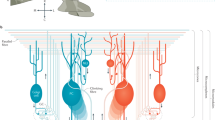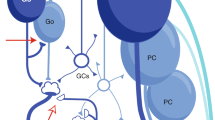Abstract
A key component of recent theories on cerebellar function is rebound firing in neurons of the deep cerebellar nuclei (DCN). Despite the robustness of this phenomenon in vitro, in vivo studies have provided little evidence for its prevalence. We found that intact mouse or rat DCN neurons rarely showed rebound firing under physiological conditions in vitro or in vivo. These observations necessitate a critical re-evaluation of recent cerebellar models.
This is a preview of subscription content, access via your institution
Access options
Subscribe to this journal
Receive 12 print issues and online access
$209.00 per year
only $17.42 per issue
Buy this article
- Purchase on Springer Link
- Instant access to full article PDF
Prices may be subject to local taxes which are calculated during checkout



Similar content being viewed by others
References
Ito, M. The Cerebellum and Neural Control (Raven Press, New York, 1984).
Jahnsen, H. J. Physiol. (Lond.) 372, 129–147 (1986).
Llinas, R. & Muhlethaler, M. J. Physiol. (Lond.) 404, 241–258 (1988).
Aizenman, C.D. & Linden, D.J. J. Neurophysiol. 82, 1697–1709 (1999).
Molineux, M.L. et al. Proc. Natl. Acad. Sci. USA 103, 5555–5560 (2006).
Kistler, W.M. & De Zeeuw, C.I. Cerebellum 2, 44–54 (2003).
Medina, J.F., Nores, W.L., Ohyama, T. & Mauk, M.D. Curr. Opin. Neurobiol. 10, 717–724 (2000).
Wetmore, D.Z., Mukamel, E.A. & Schnitzer, M.J. J. Neurophysiol. (in the press) (2007).
Pugh, J.R. & Raman, I.M. Neuron 51, 113–123 (2006).
Aizenman, C.D., Manis, P.B. & Linden, D.J. Neuron 21, 827–835 (1998).
Rowland, N.C. & Jaeger, D. J. Neurophysiol. 99, 704–717 (2008).
Aksenov, D., Serdyukova, N., Irwin, K. & Bracha, V. J. Neurophysiol. 91, 719–727 (2004).
Holdefer, R.N., Houk, J.C. & Miller, L.E. J. Neurophysiol. 93, 35–43 (2005).
Delgado-Garcia, J.M. & Gruart, A. Brain Res. Brain Res. Rev. 49, 367–376 (2005).
Lee, H.H. et al. J. Biol. Chem. 282, 29777–29784 (2007).
Acknowledgements
We thank members of the Khodakhah laboratory for helpful comments and discussion. This work was supported by grants from the US National Institutes of Health and the Human Frontier Science Program (NS050808, NS054251, GM53395, GM65473 and ND44564).
Author information
Authors and Affiliations
Corresponding author
Ethics declarations
Competing interests
Graham Ellis-Davies has filed a US patent for the synthesis of CNI-GABA.
Supplementary information
Supplementary Text and Figures
Supplementary Figures 1–4 and Supplementary Methods (PDF 275 kb)
Rights and permissions
About this article
Cite this article
Alviña, K., Walter, J., Kohn, A. et al. Questioning the role of rebound firing in the cerebellum. Nat Neurosci 11, 1256–1258 (2008). https://doi.org/10.1038/nn.2195
Received:
Accepted:
Published:
Issue Date:
DOI: https://doi.org/10.1038/nn.2195
This article is cited by
-
Cerebellum Lecture: the Cerebellar Nuclei—Core of the Cerebellum
The Cerebellum (2023)
-
Increased Purkinje Cell Complex Spike and Deep Cerebellar Nucleus Synchrony as a Potential Basis for Syndromic Essential Tremor. A Review and Synthesis of the Literature
The Cerebellum (2021)
-
The Roles of the Olivocerebellar Pathway in Motor Learning and Motor Control. A Consensus Paper
The Cerebellum (2017)
-
Gain Control of Synaptic Response Function in Cerebellar Nuclear Neurons by a Calcium-Activated Potassium Conductance
The Cerebellum (2013)



